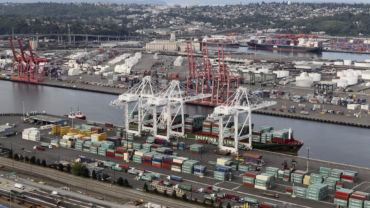Multinational companies are facing unprecedented challenges as they navigate the U.S.-China trade war, the new U.S.-Mexico-Canada Agreement (USMCA), retaliatory trade tactics, and the prospect of a hard Brexit in the U.K.
With ongoing uncertainty disrupting supply chains, roiling markets, and hitting consumers’ wallets, Thomson Reuters turned to Todd R. Smith, Principal at EY, for perspective. Smith has worked nearly 20 years as a global trade and customs consultant, providing guidance to many of the world’s largest multinational corporations.
How would you characterize the current climate?
Smith: It’s been a very frenzied and disruptive time for us in this profession. We haven’t seen a wrecking ball like this in our lifetime.
What’s an example of the impact on companies?
Smith: There are many products that historically could be imported into the U.S. duty-free. For example, zero-duty-rate products range from laptops to toys. That changed with a Tweet if the country of origin for these products is China.
And there are companies that have previously streamlined and tooled their systems and manufacturing processes to enjoy duty-free benefits under NAFTA. However, under NAFTA 2.0 (the U.S.-Mexico-Canada Agreement) you’ll be hard-pressed to find an auto industry trade compliance professional not bewildered about just how complex the new rules of origin will be to automate.
A customs’ border between the U.K. and E.U.? Let us not forget about a looming hard Brexit.
So, there’s this whole new population of companies whose heretofore mature and steady state has already, or is about to, become upended. The compliance whimpers of the past pale by comparison. Today’s disruption is impacting margin, not just data fields on a customs form. Global supply chains are radically and rapidly changing to protect earnings. And these disruptors make for a new dynamic for a large swath of the importing community.
What’s the global picture?
Smith: As disruptive as things have been in the U.S. with importing products, there’s definitely been retaliation against the U.S. in other markets. We’re very busy globally helping companies that are dealing with retaliatory tariffs being imposed on U.S. exporters in, for example, China and the European Union.
And if Brexit manifests, traders on both sides of the crossing will have a new broker fee hitting the cost of goods sold and a new import value-added tax cash flow hit to contend with. Many of our clients are global multinationals fighting these disruptors on all fronts (Section 301 tariffs on China, Section 232 steel and aluminum tariffs, USMCA, and Brexit) simultaneously. That’s the global picture.
What is your guidance for companies? How can they best prepare for whatever is coming around the corner?
Smith: They need real-time visibility into their supply chain in order to perform an analysis that would show the impact of changes that are being talked about — like Brexit — or projecting and forecasting, say, what a List 4 China 301 tariff is going to do. To mitigate these situations, they need the ability to quickly analyze and see what’s happening today.
If a company has really good technology and systems, they can do that with the push of a button, but that’s sort of a utopian state for most companies. So, we go through an exercise of interviewing and collecting data from many different sources within the company. From that, we put together a current-state analysis and model the impact of different scenarios on the supply chain and the margin.
There’s this whole new population of companies whose heretofore mature and steady state has already, or is about to, become upended. The compliance whimpers of the past pale by comparison.
And it’s not only the physical flow of product. It’s the financial flow, which can be very different. A product could go directly from China to the U.S., but there could be two legal entities in between in different countries that impact the ownership and financial flow. You need to see and understand that in order to make good decisions from a planning standpoint and a regulatory compliance standpoint.
We clearly map out and explain what, for example, a hard Brexit or NAFTA 2.0 would look like for their particular businesses. We say, “In order to mitigate, or be prepared on day one, this is what you have to do.” We develop a laundry list of actions they need to take.
Unfortunately, a lot of companies wait on the sidelines until they are faced with the hard realities.
What role does technology play in this analytical process?
Smith: A lot of the ideas we bring to clients center around technology. They should be building toward a platform that gives them answers to these types of questions at the push of a button. The way they would do that would be to automate their supply chain and their compliance via an enterprise system rather than multiple best-in-breed stand-alone systems.
What obstacles typically prevent that from happening?
Smith: What we see is that companies will have a best-in-breed approach. They’ll have Software Vendor A’s technology for a particular function like tariff classification. Then they’ll have Software Vendor B’s software solution for managing a foreign trade zone. And then they may have Software Vendor C’s solution for free trade agreements, as an example.
They may be saying, “Yeah, we’re automated,” but they’re on different systems which makes it very hard and time consuming to create meaningful reports and perform analytics. Best case in this scenario would be to have a data lake that information from all those systems would flow into for analytics and reporting. That’s why I’ve been a strong advocate and proponent of moving to an enterprise system where the data is normalized and the reporting and analytics are on a single platform.
Another issue on the tech front is how blockchain is going to impact the supply chain. I suggest companies think about that when they are looking at automation and new systems and capabilities. Trade technology will need to interface and interact with blockchains in the future. When they’re blueprinting and designing their systems, they need to determine how they’re going to communicate with various blockchains.
Are there institutional obstacles within companies, as well?
Smith: Sure. It’s budget. It’s getting the institutional support from IT and finance. It’s making this an organization-wide priority. Although today, given all the trade disruption, that’s becoming easier to do. It’s easier to make the case. What’s the saying? “We must seize upon the opportunities created by chaos.”
The interview was edited for length and clarity.




